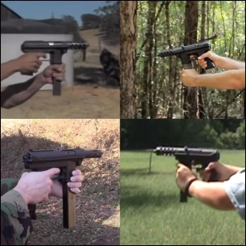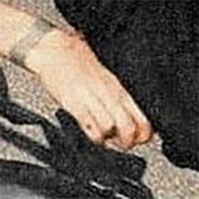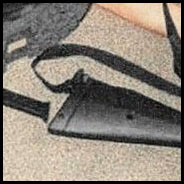Dylan Klebold's Death
Did Dylan Klebold kill himself?
If so, how? If not, what happened?
An objective, thorough
Why do people question Dylan Klebold's death?
Although Klebold’s death was ruled a suicide, some people believe he didn’t commit suicide and instead, believe Harris killed Klebold.
Some say the evidence supports this conclusion. This claim was first published in the National Enquirer alongside two leaked photos of the shooters’ bodies.
However, the evidence doesn’t support this conclusion (neither do the photos). Both the evidence and photos suggest Harris died first, which means he could not have killed Klebold.
First, let’s take a look at why people believe Harris killed Klebold.
Did Eric Harris kill Dylan Klebold?
Those who believe Harris killed Klebold generally hold the following misconceptions:
(1) Klebold could not have achieved the fatal bullet’s trajectory through his left temple using his right hand, and since the gun was found under Klebold's right hand, Harris planted the TEC-DC9M to make Klebold’s death appear as a suicide forgetting that he was left-handed.
(2) Klebold was found tightly gripping the TEC-DC9M in his right hand, and he couldn't have shot himself with his right hand so this either means Eric planted the TEC in Klebold's hand after he killed him, or Klebold was holding his TEC when Eric killed him.
(3) The TEC-DC9M was found without a magazine attached and a live round in the chamber. Since a magazine is needed to load a live round into the chamber, it's impossible for Klebold to have shot himself with no magazine in the gun and still end up with a live round in the chamber.
(4) Harris likely killed Klebold with the Hi-Point rifle--not the TEC-DC9M.
ALL of these claims are demonstrably false.
Here is the evidence-based truth:
1. The fatal trajectory would have been easy for Klebold to achieve via suicide and the fact that the TEC was found under his right hand has no bearing on what hand pulled the trigger because (1) the gun was upside down under his palm, which means if someone 'planted' the gun under his hand, they planted it upside-down, which makes no sense. And (2) the gun was attached to a strap around his body and would have fallen from his grip, remaining close to his body no matter how he (or anyone else) pulled the trigger;
2. Klebold was not found “tightly gripping” the TEC-DC9M. His fingers were "slightly curved" over the grip (backwards - with his pinky finger close to the trigger box);
3. The TEC-DC9M was found with a loaded magazine attached; and
4. The TEC-DC9M unquestionably fired the fatal shot (not the carbine). There was drawback in the barrel of the TEC matching Klebold's DNA, which means the fatal shot came from the TEC. The fatal bullet came from Firearm Discharge #11.
Now let’s look at each claim in-depth.
Point #1: The angle of Klebold's wound
Myth: The angle of Klebold's wound is impossible to achieve via suicide
Evidence-based truth: The angle would have been possible to achieve via suicide, but only in certain ways.
COULD KLEBOLD HAVE ACHIEVED THE DOCUMENTED TRAJECTORY VIA SELF-INFLICTION?
Short answer: Yes, it would have been possible by gripping the pistol with two hands.
Klebold’s wound was found ‘consistent with suicide’
This is the approximate trajectory of the bullet that killed Klebold. Since we don’t have autopsy diagrams, it’s hard to determine the exact points of entry and exit.

Dr. Ben Galloway, the coroner who examined Klebold’s body, described the wound:
“The projectile penetrated the cranium through the left temporal bone; extended across the undersurface of both cerebral hemispheres; exiting the head through the right temporal bone…
The projectile traveled left to right slightly front to back and slightly downward. The characteristics of the wound are consistent with a large calibre weapon; with a close contact range of fire; consistent with self-infliction.”
-Klebold’s autopsy report
Klebold's wound was found to be "consistent with suicide," but there's something contradictory about what Dr. Galloway described in the autopsy report. He wrote, "The projectile traveled left to right slightly front to back and slightly downward. The characteristics of the wound are consistent with... self-infliction.” According to decades of research, a downward bullet path is indicative of homicide, not suicide.
From a study published in 2002 titled Autopsy features relevant for discrimination between suicidal and homicidal gunshot injuries:
"Consequently, some bullet path directions cannot be considered indicative of suicide: downwards and back-to-front in gunshots to the temple, left-to-right in gunshots to the left chest and downwards in mouth shots. The isolated autopsy findings can only be indicative of suicide or homicide but the combined analysis of several findings can be associated with a high probability."
It's also uncommon for suicides to have no barrel contact, although it does happen. It's just rare. Given the weight and size of Klebold's pistol combined with the angle that would have bent his wrists unnaturally inward, it's hard to believe he shot himself with one hand pulling the trigger.
Klebold has two unusual wound characteristics for a suicide: no contact and a downward bullet path.
Although these points should be taken into account - a downward bullet path by itself, and a lack of barrel contact - it doesn't mean Klebold was killed. It's possible that he engaged in a rushed, sloppy suicide where he grabbed the pistol with two hands, didn't press the barrel to his head, and pulled the trigger quickly as he moved the gun to his temple.
Could Klebold have achieved this angle via suicide?
While he couldn’t have achieved the documented trajectory by pulling the trigger with his right hand only, it would have been easy and natural for him to achieve the documented trajectory via self-infliction while holding the gun with both hands.
Possibilities: (1) He could have held the grip with both hands, right hand on the bottom, pulling the trigger with his left thumb… or (2) He could have held the magazine in his right hand, the grip in his left hand, pulling the trigger with his left thumb.
If holding the magazine sounds like an awkward way to commit suicide, rest assured, it’s not. It’s actually the most natural way to turn a TEC-9 on yourself.
Why would Klebold hold the magazine (if he did?)
The TEC-DC9M magazine is forward of the grip, making the pistol unbalanced and front-heavy. In the absence of a mounted forward pistol grip, which is illegal, people commonly fire TEC-9 models by holding the magazine in their non-dominant hand.
It would have been natural for Klebold to hold the magazine in his right hand with his left hand on the grip. From there, it would have been a simple, natural movement to turn the gun on himself and fire the fatal shot pulling the trigger with his left hand while still holding the magazine in his right hand to steady the shot. From there, the gun would have fallen, but since it was on a strap, it would have stayed close to his body as he fell. Since his right palm was resting over the gun backwards, there is no reason to believe he 'gripped the gun' as he died, so this scenario makes sense.
You'll see the simplicity of this movement below.
It’s natural to hold the magazine when firing a TEC-9

If Klebold held his pistol this way, it would have been natural and easy to turn the gun to his left temple at the documented angle and pull the trigger while achieving the documented angle.
Put video here showing the movement.
The fact that Klebold’s right fingers were found slightly curved over the grip indicates he was gripping that part of the pistol when he died. However, remember that this was an upside-down grip. The most logical answer is that the gun fell underneath his body as he fell to the floor and he grabbed for the gun as he died.
Point #2: In what position was Klebold's TEC found underneath his leg?
Myth: The TEC-DC9M was found under Klebold's leg with the open end of the magazine well facing away from his right leg.
Evidence-based truth: The TEC-DC9M was found under Klebold's leg with the open end of the magazine well facing between his legs, toward his left leg.
Most people assume the TEC-DC9M was found underneath Klebold's leg with the magazine well pointing out from his right leg, away from his body. However, it was actually found in the opposite orientation. The magazine was pointing toward his left leg.
Point #3: There is no TEC-DC9M in the leaked photos
Myth: The "suicide photos" leaked to the National Enquirer show the TEC-DC9M under Klebold's leg and right hand.
Evidence-based truth: There is no TEC-DC9M in the leaked photos; it was removed from the scene hours earlier.
This misperception is an optical illusion created by the leaked photos that imply the gun is under Klebold's right hand in the photo. In fact, there is no TEC-DC9M in the leaked photos. It has already been removed from the scene. Only the strap is under Klebold's hand.
When Klebold's body was found, both the TEC and his hand were concealed under his leg. In the leaked photo, the TEC's strap has been visibly cut and the pistol has been removed, which is why his right hand is now completely visible. When found, his hand was concealed underneath his leg.
Why is the strap in Klebold's hand?
The TEC-DC9M has a single sling point mount for the strap on the back of the pistol. When investigators removed the pistol from underneath Klebold's right hand, there would be a section of strap next to his hand. It makes sense that after removing the pistol, his hand would then naturally come to rest on top of the strap.
Point #4: Klebold was not found "tightly gripping" the pistol
Myth: Klebold was found "tightly gripping" the TEC-DC9M.
Evidence-based truth: JCSO detective Jim Jennings documented Klebold’s fingers as being “slightly curled” with his palm down.


Does this look like a tight grip? Klebold's index and middle fingers are loosely curled and his middle finger is so loosely curled that you can see the inside of his finger. You could probably stick a toothbrush through his pointer and middle fingers they’re so loose. This is not a tight grip.
Why does it matter if Klebold’s hand was tightly gripping the pistol?
When you think he was found “tightly gripping” the pistol, the next question is, “why would he be gripping the pistol with his right hand when it would have been impossible for him to shoot himself with his right hand? Eric must have killed him!” This conclusion is based on a faulty premise.
Point #5: The TEC-DC9M was found with a magazine attached
Myth: Klebold's TEC-DC9M was found without a magazine attached and one round in the chamber.
Evidence-based truth: Klebold's TEC-DC9M was found WITH a loaded magazine attached and one round in the chamber.
Page 12325 from the Library Teams 1-7, Team Two report describes the condition of each weapon as it was found.
The TEC-DC9M is described as being found with “one round in chamber, live rounds in magazine.”

The original handwritten notes documenting the condition of the firearms found, including whether the safety was on or off, can be found in the CBI documents.

The TEC-DC9M was originally documented as “loaded mag 1 in chamber safety? NO.” (Source: CBI; Crime Scene Report Team Two, p.347)
Why does it matter if there was a magazine in the TEC-DC9M?
A live round in the chamber of the TEC-DC9M indicates the last shot was fired while a magazine was attached. After each shot from a semi-automatic pistol, a round is loaded into the chamber, fed from the magazine. A pistol won’t load a new round in the chamber without a magazine attached. No magazine would mean either (a) someone removed the magazine after the fatal shot was fired or (b) the fatal shot wasn’t fired from the TEC-DC9M.
If Klebold shot himself with the TEC-DC9M without a magazine inserted, the chamber would be empty.
However, all of these points are irrelevant since the TEC-DC9M was, in fact, found with a loaded magazine.
Three troublesome conclusions are drawn from the false belief that the TEC-DC9M was found without a magazine:
(1) Klebold couldn’t have killed himself with a pistol that didn’t have a magazine attached and feed a live round into the chamber. (true, but the pistol was found with a loaded magazine so this conclusion is invalid)
(2) The only other person in the room was Harris, therefore Harris killed Klebold. (this is an assumption and is demonstrably false)
(3) Without a magazine attached, the TEC-DC9M could not have been the weapon that fired the fatal shot. Unless the person who fired the fatal shot removed the magazine afterward and placed the pistol in Klebold’s hand. (true, but the TEC-DC9M was found with a magazine attached and was the gun that fired the fatal shot, which makes this conclusion invalid)
Some people argue that when the TEC-DC9M was described as being found with “one round in chamber, live rounds in magazine,” that doesn’t mean the magazine was inserted into the weapon. However, that’s exactly what it means.
Investigators do not document the condition of a weapon when found by including a description of a magazine found on the floor near the firearm. Only an inserted magazine would be described as part of the firearm’s condition when found.
The documented condition of the TEC-DC9M proves the magazine was inserted into the TEC-DC9M when recovered by investigators.
If you’re still not convinced the magazine was inserted into the TEC, consider that Harris’ rifle was documented as ‘empty,’ yet a rifle magazine was located right next to the firearm. The rifle’s magazine was not documented as part of the rifle’s condition. Only an inserted magazine would be documented as part of a firearm’s condition when found.
 |
 |
|---|
Here
What about the CBI document that recorded the TEC-DC9M as being received without a magazine?
This document has nothing to do with the crime scene and referencing this document in support of the pistol being found without a magazine is a gross misunderstanding.
The document in question is a record of the CBI receiving the TEC-DC9M as evidence on May 4, 1999 so it could be test fired. The pistol was documented as it arrived to the CBI lab without a magazine.
It should be noted that it’s generally against protocol to ship or transport a loaded firearm or a firearm with a magazine attached. Chambers must be empty and magazines must be detached before being transported even in a vehicle.


